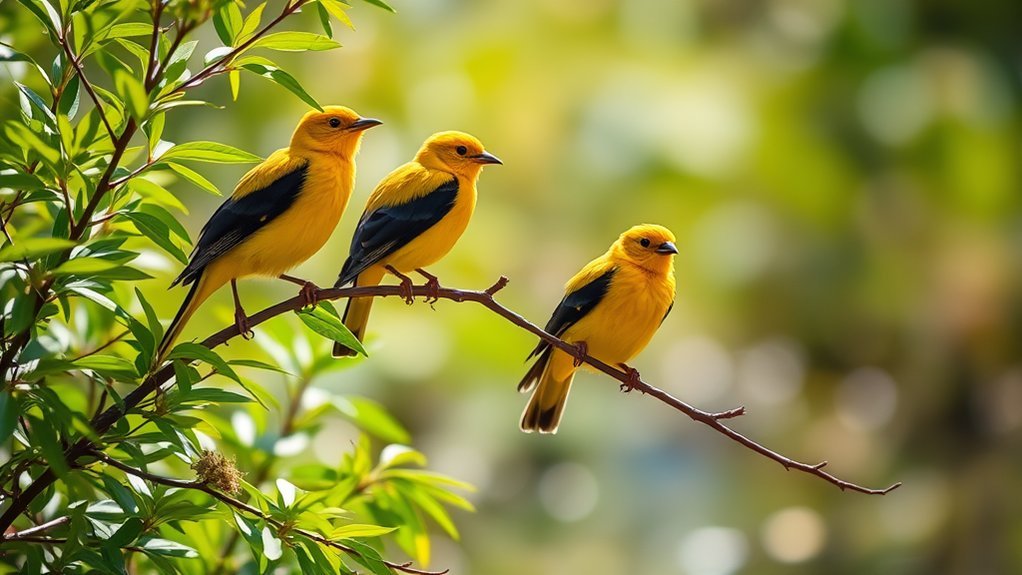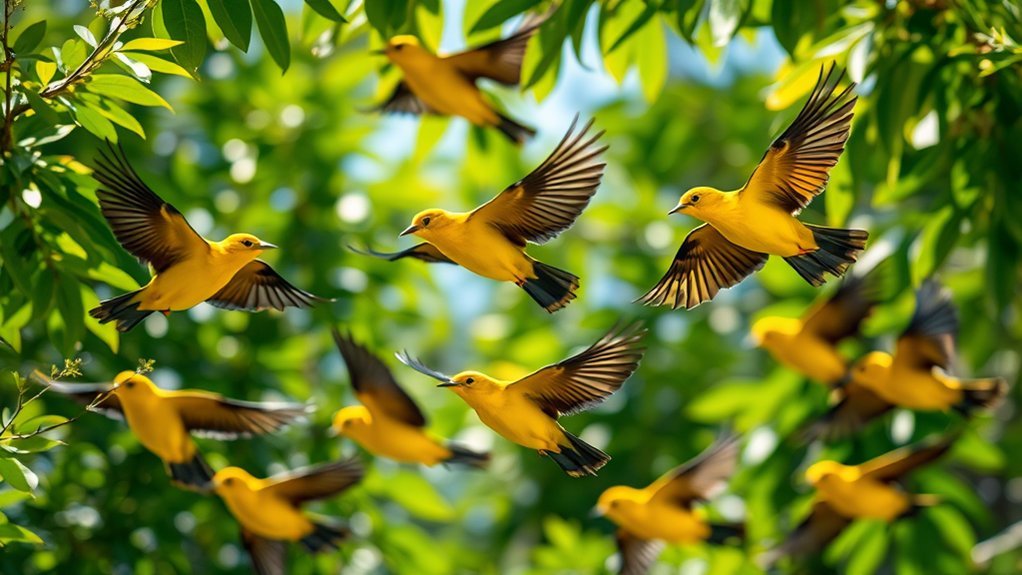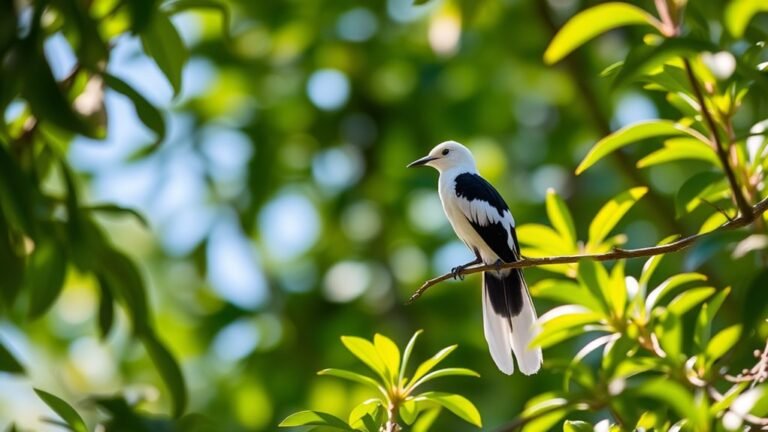Yellow Birds With Black Wings: Ultimate Guide
Yellow birds with black wings have unique features and behaviors. Their bright colors help with identification. Knowing their habitats and feeding behaviors gives insight into their role in the environment. This knowledge enhances your understanding and appreciation of these birds.
Their nesting habits reveal how adaptable they are. Studying these behaviors can give us important information about their survival strategies and the challenges they encounter. By learning about these aspects, you can better appreciate the resilience of these beautiful creatures.
Key Takeaways
Yellow birds with black wings use bright colors to attract mates and mark their territory. This display shows they are healthy and strong. A well-known example is the Western Meadowlark, recognized by its yellow breast and unique black "V" shape on its throat.
These birds thrive in open grasslands and wetlands. They can adapt to different environments for nesting and protection. Their diet consists of seeds, insects, and acorns. They use various feeding methods to gather food, which is essential for their survival and the ecosystem.
During mating season, male birds perform colorful displays. They build hidden nests for their young, using different materials for protection. Their vibrant behaviors and adaptability make them fascinating to observe.
Overview of Yellow Birds With Black Wings

Yellow birds with black wings are a unique group within bird species. Their bright colors help them attract mates and defend their territory. Yellow bird facts show that their color can reflect health. Bright colors often mean a bird is well-fed.
The black wings of these birds serve various purposes. They can help improve flight efficiency and provide camouflage from predators. Understanding these features helps you see how they survive in the wild.
Each species has different traits, yet they share common characteristics that connect them to other birds. Learning about yellow birds with black wings can deepen your knowledge of these creatures. This information also supports bird conservation efforts.
Enjoy exploring this vibrant group of birds!
Notable Species and Their Identification
The Western Meadowlark is a striking yellow bird with black wings. To identify this species, observe these key features:
- A bright yellow breast that sharply contrasts with its black wings.
- A distinct black "V" shape on its throat.
- Subtle brown streaks on the back, providing texture.
- Yellow undertail feathers that are visible in flight.
Recognizing these traits can enhance your birdwatching experience.
Enjoy connecting with the unique characteristics of the Western Meadowlark in your local area.
Habitat Preferences of Yellow Birds

Yellow birds, like the Western Meadowlark, thrive in different habitats. They prefer open grasslands, wetlands, and urban parks. These environments support their survival.
Yellow birds adapt to changes in weather, including temperature and rainfall. During the breeding season, they seek areas with dense plants for shelter and nesting. In winter, they often choose agricultural fields because of the food available there.
Knowing their habitat preferences helps us understand their needs and aids conservation efforts. You can create spaces that attract these beautiful birds by promoting habitat diversity, strengthening community connections along the way.
Feeding Habits and Diet
Birds exhibit diverse feeding habits and diets, which are vital for their survival. Their seed choices and foraging methods highlight their adaptability and resourcefulness.
Here are some common techniques:
- Ground Foraging: Birds scratch the ground to find seeds hidden in the soil.
- Acorn Picking: In autumn, they gather acorns for an energetic food source.
- Thistle Seed Feasting: During late summer, they cling to plants to eat nutritious thistle seeds.
- Insect Snatching: They hunt insects to add protein to their diets, especially during breeding season.
These feeding techniques enrich their diets and help them thrive in different environments, showcasing the important role they play in the ecosystem.
Nesting Behavior and Reproduction

Nesting behavior and reproduction are vital for birds. They influence the survival of their species.
During mating season, male birds use colorful feathers to attract females. This display shows their health and genetic strength.
Once a couple forms a bond, they build a nest. They choose hidden spots and gather materials like sticks, grass, and feathers. These nests provide safety for their young.
The design of the nest shows how birds adapt to their environment. Through these actions, birds demonstrate the importance of reproduction for their survival.
This process is particularly evident in yellow birds with black wings.
Migration Patterns and Seasonal Changes
Yellow birds with black wings follow specific patterns during seasonal changes. Their migration depends on several key factors:
- Daylight: Changes in light signal when they should leave or arrive.
- Food Sources: The type and amount of food available shift with the seasons.
- Weather: Rain, temperature changes, and winds influence their travel routes.
- Habitat: Changes in land use, such as urban development, can create new paths or obstacles.
These factors play crucial roles in guiding their journeys each year.
Understanding these influences helps us appreciate how yellow birds adapt to their environment.
Tips for Birdwatching and Spotting Yellow Birds
To spot yellow birds with black wings effectively, follow these clear steps.
First, learn about their habitats. They often live in open woodlands and near water sources.
Second, use quality binoculars with at least 8x magnification to see details better.
As you observe, scan the area patiently. Look for movement or bright yellow colors among green leaves. Listening to their calls can also help you locate them, as recognizing their sounds increases your chances of spotting them.
Wearing camouflage clothing can help you blend in and avoid startling the birds.
Lastly, consider joining local birdwatching groups. This allows you to share tips and experiences with others, making your birdwatching journey more enjoyable and enriching.
Frequently Asked Questions
Are Yellow Birds With Black Wings Found in Urban Areas?
Yes, yellow birds with black wings can be found in urban areas. These birds adapt to city life well. They use trees and parks for nesting. This shows their ability to thrive alongside human activities.
What Are the Common Predators of Yellow Birds?
Yellow birds face threats from predators like hawks and cats. To stay safe, they use defenses such as blending in with their surroundings, flying quickly, and forming flocks. These behaviors help them evade danger and improve their chances of survival. Observing these birds can highlight their resourcefulness in the wild, making them fascinating subjects for nature lovers.
How Do Yellow Birds Communicate With Each Other?
Yellow birds communicate using specific calls and social behaviors. Their vocalizations help build friendships, mark territories, and encourage teamwork. Observing these interactions shows how they work together and strengthen their social bonds.
Do Yellow Birds With Black Wings Migrate Alone or in Groups?
Yellow birds with black wings migrate in groups. This helps them stay safe and find their way to new habitats. Traveling together strengthens their social bonds and makes the journey easier.
Can Yellow Birds With Black Wings Be Kept as Pets?
You can keep yellow birds with black wings as pets. To ensure their health and happiness, focus on proper care and specific dietary needs. Pay attention to their requirements, and you will have a joyful companion bird.

Kashvi is a passionate bird enthusiast and nature lover who has been fascinated by the world of birds for years. With a keen eye for detail and a love for learning, Kashvi is dedicated to sharing her knowledge and insights with fellow bird enthusiasts on Avian Enthusiasts. Through her engaging and informative articles, Kashvi aims to inspire others to join her in exploring the fascinating world of birds and to promote a deeper appreciation for these incredible creatures.







